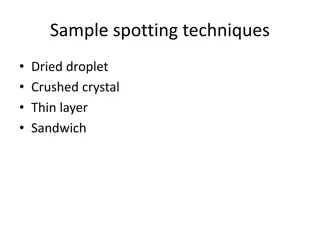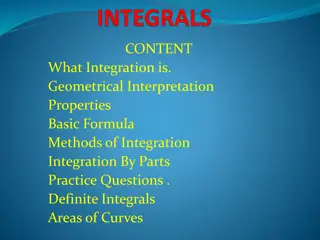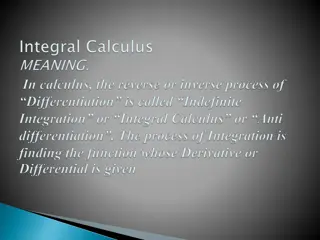
Calculating Volume of Solids of Revolution
Learn how to calculate the volume of solids of revolution by understanding the concept of rotating curves around different axes using Geogebra and integral calculus. Explore methods for estimating volumes using thin discs and integrating to enhance accuracy.
Uploaded on | 1 Views
Download Presentation

Please find below an Image/Link to download the presentation.
The content on the website is provided AS IS for your information and personal use only. It may not be sold, licensed, or shared on other websites without obtaining consent from the author. If you encounter any issues during the download, it is possible that the publisher has removed the file from their server.
You are allowed to download the files provided on this website for personal or commercial use, subject to the condition that they are used lawfully. All files are the property of their respective owners.
The content on the website is provided AS IS for your information and personal use only. It may not be sold, licensed, or shared on other websites without obtaining consent from the author.
E N D
Presentation Transcript
Sample from Study Session 4 Sample from Study Session 4 4. Applications 4. Applications FMSP Wales Professional Learning 2021/2 WJEC Further Maths Unit 4
Solids of Revolution The diagram shows the curve ? = 1 + 0.1?2 (1 ? 4) and the solid that is generated when this curve is rotated fully around the x-axis. Use GEOGEBRA to obtain views from different aspects. Use GEOGEBRA to obtain views from different aspects.
Solids of Revolution The diagram shows the curve ? = 1 + 0.1?2 (1 ? 4) and the solid that is generated when this curve is rotated fully around the y-axis. Use GEOGEBRA to obtain views from different aspects. Use GEOGEBRA to obtain views from different aspects.
How can we calculate the volume of these solids of revolution ? Let is start by considering the volume, Vx, of the solid of revolution generated when the curve ? = f ? ? ? ? is rotated fully about the x-axis. y y x x a a b b x Consider what happens when the thin strip of height f(x) and width x is rotated fully about the x-axis. We obtain a very thin cylinder of radius f(x) and depth x. The volume of this thin cylinder is ?f ?2??
We can estimate the volume, Vx, of the solid of revolution by adding up the volumes of all of these discs as x varies from a to b. ? ?f ?2?? ?? ?=? To increase accuracy we must use more, thinner, discs so we can write ? ?f ?2?? ??= lim ?? 0 ?=? Our earlier work tells us we can replace the limit of a sum by an integral ? ??2 ?? ? or ?? ???? ??= ? ?
Let is start by considering the volume, Vy, of the solid of revolution generated when the curve ? = f ? ? ? ? is rotated fully about the y-axis. y y d d c c x x a a b b Consider what happens when the thin horizontal strip of width x and height y is rotated fully about the x-axis. We obtain a very thin cylinder of radius x and depth y. The volume of this thin cylinder is ??2??
y We can estimate the volume, Vy, of the solid of revolution by adding up the volumes of all of these discs as y varies from c to d. d c ? x ??2?? ?? a b ?=? To increase accuracy we must use more, thinner, discs so we can write ? ??2?? ??= lim ?? 0 ?=? Our earlier work tells us we can replace the limit of a sum by an integral ???? ? Alternatively, using substitution ? ????? The limits are y limits To do the integration, we will need to write ?2 in terms of y ????? ??= ? ??= ???? ?
Example 2 : Find, in terms of , the volumes of revolution when the curve 6 ? (1 ? 9) is rotated about a) the x-axis; ? =
Example 2 : Find, in terms of , the volumes of revolution when the curve 6 ? (1 ? 9) is rotated about a) the x-axis; b) the y-axis. ? =
Establishing the formulae for the volumes of a cone and a sphere: ? ?? ? ? ?completely around the x-axis gives a cone of radius r and Rotating line ? = height h. ? ?? = ??2 ?2 ?? = ??2 ?3 3 = ??2 3 3 0 =1 2 3??2 ??= ? ? 2 2 2 0 0 0 ?? ?? ? ? ?completely around the x-axis gives a Rotating the semi-circle ? = sphere of radius r. ? ? ? ?2 ?2?? = ? ?2? ?3 2 ?2 ?2 ??= ? ?? = ? 3 ? ? ? 2?3 3 2?3 =4 3??3 = ? 3






















